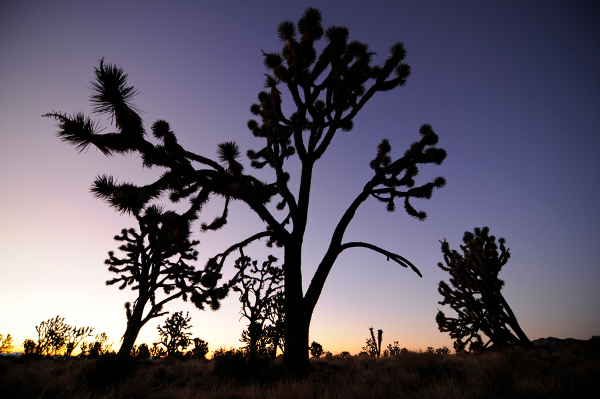
The proposed Avi Kwa Ame National Monument would expand protections offered by the Wee Thump
Joshua Tree Wilderness west of Searchlight, Nevada. Photo by Brian Beffort
By Christian Gerlach, Our Wild America Organizer
Support is growing for another national monument in Nevada. According to a recent article in E&E News, “another potential Antiquities Act beneficiary could be a future Avi Kwa Ame, or Spirit Mountain, monument in Clark County, Nevada,” designated by President Joe Biden. This announcement follows an effort for years to protect the area surrounding the Wee Thump Joshua Tree Wilderness, Grapevine Canyon, and the Spirit Mountain Wilderness. This effort has been led by the Fort Mohave Tribe, or Pipa Aha Macav, People by the River as they refer to themselves. Other organizations like the National Parks Conservation Association, Basin and Range Watch, Conservation Lands Foundation have also been pushing for further protections. Our Sierra Club Southern Nevada Group Executive Committee member Justin McAffee has been leading the Sierra Club charge for Avi Kwa Ame’s greater recognition and protections.
The area is a magnificent extension of the Joshua Tree forest and majestic landscapes already protected by the Mojave National Preserve and Castle Mountains National Monument immediately adjacent across the California line. These protections would safeguard a complex, connected natural system that helps us protect endangered species, invite more people to enjoy public lands, act as defense against climate disruption and further our need to protect 30% of the nation’s lands and waters by the year 2030. The Avi Kwa Ame National Monument would protect the eastern portion of the world’s largest Joshua tree forest, including the world's third largest Joshua Tree. The oldest of these ancient wonders have survived for over 900 years. These living elders have much to teach us and must be protected.
The surrounding mountain ranges, like the McCullough Range, Spirit Mountains, New York Mountains, and Castle Mountains, are home to a wide variety of raptor species including Golden Eagles. These birds of prey utilize the valley and Joshua Tree forest that would make up this new national monument as their hunting grounds. Preserving these lands would protect these species by ensuring that there are healthy populations of desert fauna they need to survive. The area contains one of the highest known densities of golden eagles in Nevada. In addition, nearly two dozen species of raptors reside in the proposed monument including bald eagles, peregrine falcons, and western screech owls. The area has been designated as important to birding for the unique and diverse birds that inhabit these lands other than the birds of prey, including gilded flickers and curved-billed thrashers. The extinction crisis is ongoing. Birds are taking the hardest hit from this, and we need to protect more habitat for them.
Part of the monument would include the Paiute/Eldorado Area of Critical Environmental Concern (ACEC), which was established to protect the federally threatened desert tortoise. However, this ACEC is not sufficient to protect all the special species, wildlife corridors and important historic, cultural, visual, and recreational resources of the region. The designation of Avi Kwa Ame National Monument would be a huge step forward.
Among the species with iconic importance to Nevada and deep cultural significance to local Indigenous people that stand to benefit from the proposed monument is the desert bighorn sheep, Nevada’s state animal. Within the proposed monument boundaries is an important migratory corridor for a herd of desert bighorn that lives on the steep, rocky slopes of the Castle Mountains and the New York Mountains.
The Castle and New York mountain ranges that would be a part of the monument also house the Crescent Town Site Area of Critical Environmental Concern. The townsite contains a prehistoric mining site of turquoise used by Native Americans like the Southern Paiutes, Western Shoshone, and Mohave peoples going back hundreds of years. Also within the southern part of the proposed Monument is a section of the historic Mojave Trail, which was originally used by Mojave and other Indigenous Americans to transport goods from the southwest to trade with the Chumash and other coastal tribes. The area is of further significance to local indigenous people as Spirit Mountain, the Dead Mountains, and the surrounding area are closely tied to the creation stories, cosmology, and well-being of the 10 groups of Yuman-speaking peoples. The area also has cultural importance to the Mohave People, Chemehuevi Paiute, Moapa Paiute, Las Vegas Paiute, and Hopi people.
The Southern Nevada group of the Sierra Club passed a resolution of support for this proposed national monument. These monument protections represent an opportunity for our nation to walk the walk of centering equity and justice by helping preserve what is left of the cultural and religious heritage of Indigenous peoples in this region. We look forward to a new presidential administration that will help us achieve these wins for conservation and the rights of Indigenous people. Designating this Avi Kwa Ame or Spirit Mountain National Monument would be a great step toward achieving these goals.
Support the Sierra Club's work to protect valuable landscapes across Nevada and the eastern Sierra!
1 https://pubs.usgs.gov/sir/2006/5197/sir2006-5197b.pdf Page numbered B15 but page number 14 in the pdf document
